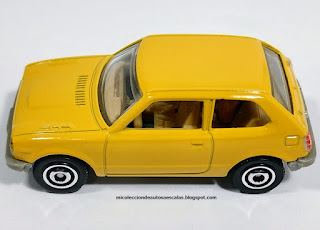Un 1976 Honda Civic CVCC Matchbox escala 1:64.
La primera generación del Civic fue lanzada al mercado en julio de 1972. Inicialmente tenía una carrocería Cupé de dos puertas, a la que se añadió un Hatchback de tres puertas en septiembre de ese año. Más tarde fueron añadidos los Hondamatic (con transmisión automática) y Civic CVCC en 1973. Estos fueron complementados en 1974 por el deportivo Civic RS2, y una versión Station Wagon. Durante tres años consecutivos, desde 1972 a 1974, el Civic recibió el premio al "Coche de Año en Japón". Fuera de Japón, el Civic CVCC3 obtuvo un alto reconocimiento en los Estados Unidos. En 1973, el Civic quedó en tercer lugar en la elección del Coche del Año en Europa, el mejor resultado hasta el momento obtenido por un vehículo japonés. En los EE.UU., la campaña publicitaria para introducir el Civic fue "Honda, lo hacemos simple."





















































